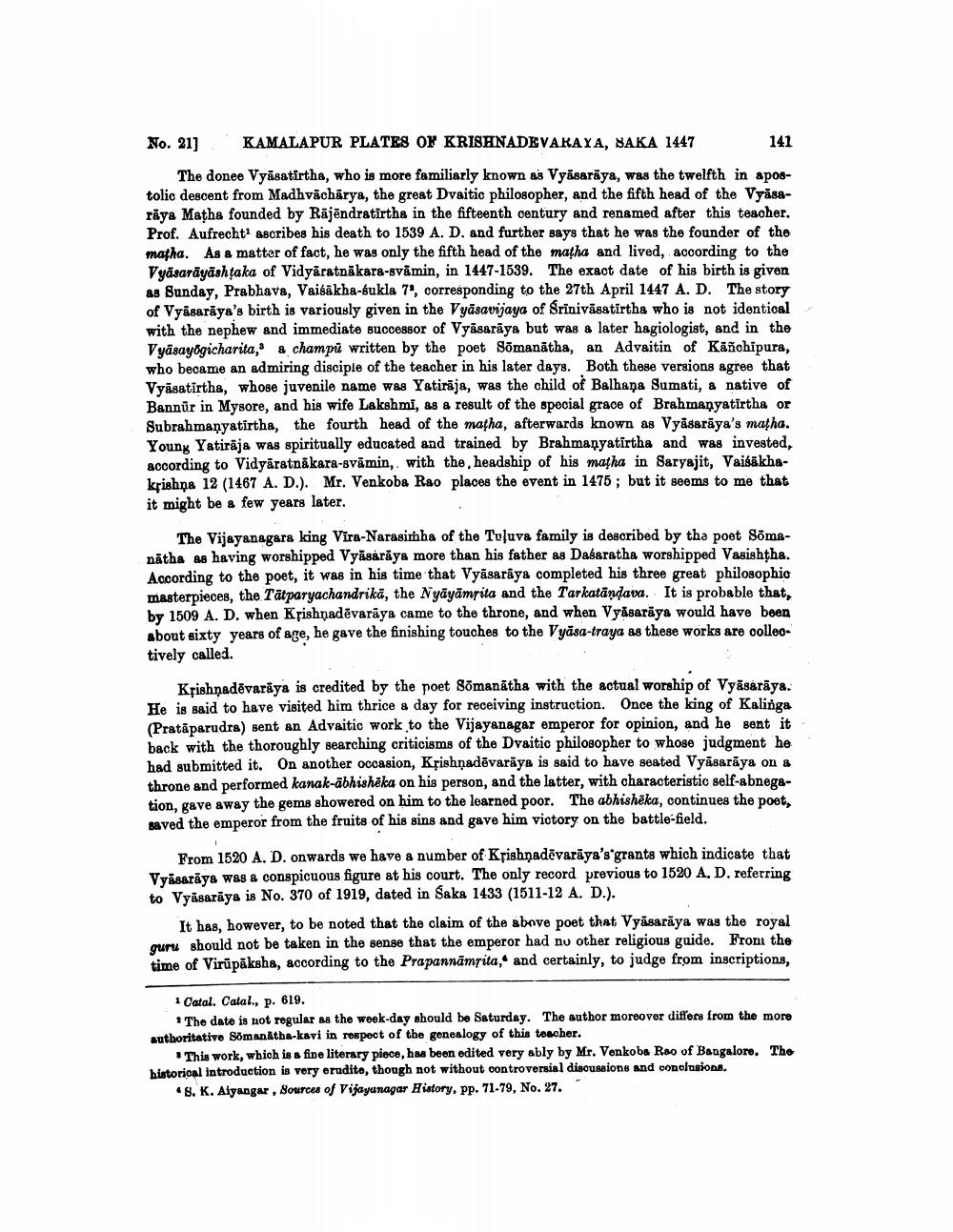________________
No. 21]
KAMALAPUR PLATES OF KRISHNADEVARAYA, SAKA 1447
141
The donee Vyasatirtha, who is more familiarly known as Vyasaraya, was the twelfth in apostolic descent from Madhvacharya, the great Dvaitic philosopher, and the fifth head of the Vyasaraya Matha founded by Rajendratirtha in the fifteenth century and renamed after this teacher. Prof. Aufrecht1 ascribes his death to 1539 A. D. and further says that he was the founder of the matha. As a matter of fact, he was only the fifth head of the matha and lived, according to the Vyasarāyāshtaka of Vidyaratnakara-svamin, in 1447-1539. The exact date of his birth is given as Sunday, Prabhava, Vaisakha-sukla 7, corresponding to the 27th April 1447 A. D. The story of Vyasaraya's birth is variously given in the Vyasavijaya of Srinivasatirtha who is not identical with the nephew and immediate successor of Vyasaraya but was a later hagiologist, and in the Vyasayogicharita, a champu written by the poet Sōmanatha, an Advaitin of Kanchipura, who became an admiring disciple of the teacher in his later days. Both these versions agree that Vyasatirtha, whose juvenile name was Yatiraja, was the child of Balhana Sumati, a native of Bannur in Mysore, and his wife Lakshmi, as a result of the special grace of Brahmanyatirtha or Subrahmanyatirtha, the fourth head of the matha, afterwards known as Vyasaraya's matha. Young Yatiraja was spiritually educated and trained by Brahmanyatirtha and was invested, according to Vidyaratnakara-svamin, with the, headship of his matha in Saryajit, Vaisakhakrishna 12 (1467 A. D.). Mr. Venkoba Rao places the event in 1475; but it seems to me that it might be a few years later.
The Vijayanagara king Vira-Narasimha of the Tuluva family is described by the poet Somanatha as having worshipped Vyasaraya more than his father as Dasaratha worshipped Vasishtha. According to the poet, it was in his time that Vyasaraya completed his three great philosophic masterpieces, the Tatparyachandrika, the Nyayamrita and the Tarkatändava. It is probable that, by 1509 A. D. when Krishnadevaraya came to the throne, and when Vyasaraya would have been about sixty years of age, he gave the finishing touches to the Vyasa-traya as these works are colleotively called.
Krishnadevaraya is credited by the poet Sōmanatha with the actual worship of Vyasaraya. He is said to have visited him thrice a day for receiving instruction. Once the king of Kalinga (Prataparudra) sent an Advaitic work to the Vijayanagar emperor for opinion, and he sent it back with the thoroughly searching criticisms of the Dvaitic philosopher to whose judgment he had submitted it. On another occasion, Krishnadevaraya is said to have seated Vyasaraya on a throne and performed kanak-abhisheka on his person, and the latter, with characteristic self-abnegation, gave away the gems showered on him to the learned poor. The abhisheka, continues the poet, saved the emperor from the fruits of his sins and gave him victory on the battle-field.
From 1520 A. D. onwards we have a number of Krishnadevaraya's'grants which indicate that Vyasaraya was a conspicuous figure at his court. The only record previous to 1520 A. D. referring to Vyasaraya is No. 370 of 1919, dated in Saka 1433 (1511-12 A. D.).
It has, however, to be noted that the claim of the above poet that Vyasaraya was the royal guru should not be taken in the sense that the emperor had no other religious guide. From the time of Virupaksha, according to the Prapannāmrita, and certainly, to judge from inscriptions,
1 Catal. Catal., p. 619.
The date is not regular as the week-day should be Saturday. The author moreover differs from the more authoritative Sömanätha-kavi in respect of the genealogy of this teacher.
This work, which is a fine literary piece, has been edited very ably by Mr. Venkoba Rao of Bangalore. The historical introduction is very erudite, though not without controversial discussions and conclusions.
S. K. Aiyangar, Sources of Vijayanagar History, pp. 71-79, No. 27.




